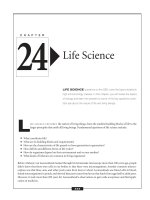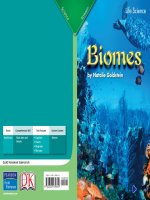2 2 animal groups (life science)
Bạn đang xem bản rút gọn của tài liệu. Xem và tải ngay bản đầy đủ của tài liệu tại đây (3.24 MB, 14 trang )
Life Science
Animal
Groups
by Carol Levine
Genre
Nonfiction
Comprehension Skill
Alike and Different
Text Features
• Call Outs
• Glossary
Science Content
Vertebrates and
Invertebrates
Scott Foresman Science 2.2
ISBN 0-328-13773-1
ì<(sk$m)=bdh dc< +^-Ä-U-Ä-U
Vocabulary
amphibian
bird
camouflage
fish
gills
insect
mammal
reptile
Picture Credits
Every effort has been made to secure permission and provide appropriate credit for photographic material.
The publisher deeply regrets any omission and pledges to correct errors called to its attention in subsequent editions.
Photo locators denoted as follows: Top (T), Center (C), Bottom (B), Left (L), Right (R), Background (Bkgd).
Minden Pictures: 1 (TL): © Natural History Museum, London/DK Images; 4 (BC) © Jerry Young/DK Images;
5 (CR): © Pete Atkinson/NHPA; 6–7: © Norbert Rosing/National Geographic Image Collection;
7 (C): © Jerry Young/DK Images; 10–11: © Pete Atkinson/NHPA; 11 (C): © Norbert Wu/Minden Pictures;
16–17: © David Wrobel/Visuals Unlimited; 18: © Natural History Museum, London/DK Images;
19: © Natural History Museum, London/DK Images; 22: © Jeff Rotman/Nature Picture Library.
Unless otherwise acknowledged, all photographs are the copyright © of Dorling Kindersley, a division of Pearson.
ISBN: 0-328-13773-1
Copyright © Pearson Education, Inc. All Rights Reserved. Printed in the United States of America.
This publication is protected by Copyright, and permission should be obtained from the publisher prior to any
prohibited reproduction, storage in a retrieval system, or transmission in any form by any means, electronic,
mechanical, photocopying, recording, or likewise. For information regarding permission(s), write to
Permissions Department, Scott Foresman, 1900 East Lake Avenue, Glenview, Illinois 60025.
3 4 5 6 7 8 9 10 V010 13 12 11 10 09 08 07 06 05
What did you learn?
1. How does an arctic fox’s fur
change in the winter?
Animal
2. How does camouflage protect
a chameleon?
Groups
3.
by CarolSnails
Levineand
jellyfish do not have backbones.
Write to explain how these
animals stay safe. Include
details from the book to
support your answer.
4.
Alike and Different How is
an octopus like an earthworm?
How is it different?
Introduction
There are many kinds of animals.
Animals belong to different groups.
Different animals have different body
parts. The parts an animal has
can tell us which group it is in.
One group of animals has
backbones. Bones help animals
move. Bones give animals their
shape. Bones can even protect
an animal’s other body parts.
2
3
Animals with Backbones
There are many groups of animals with
backbones. Mammals, birds, fish, reptiles,
and amphibians are all groups
of animals with backbones.
Even though these animals have backbones,
they are different from one another. Animals
are different because they live in different
environments. Animals have adapted to
their environment.
4
5
Mammals
Some animals are mammals. Mammals
have backbones. Most mammals have fur
or hair on their bodies. Mammals live in
many different environments. Mammals
are adapted to live in their environment.
6
Some mammals change colors to hide in
their environment. This is called camouflage.
One mammal that uses camouflage is the
arctic fox. In winter the fox’s fur changes from
gray or brown to white. This helps the fox
hide in the snow.
7
This woodpecker’s beak is strong.
The beak helps the bird to make
holes in trees. The woodpecker’s
tongue is long and sticky. It uses
its tongue to get insects from inside
the tree.
Birds
Some animals are birds.
Birds have backbones. They have
feathers and wings. Many birds
use their feathers and wings to fly.
Birds also live in many different
environments. Birds are adapted to
live in their environment.
8
9
shark
remora
Fish
Some animals are fish. Some fish have
backbones. Fish live in the water. Fish are
adapted to live in this environment.
Most fish have scales. Most fish have
fins. Scales and fins help fish swim. Fish
have gills. Gills help fish get the oxygen
they need to live.
10
The remora fish has a sucker on its
head. This fish stays safe by using its
sucker to stick to other sea animals.
Sometimes remoras stick to sharks.
Sharks keep remoras safe.
11
The chameleon can change from yellow
to green to brown. Different things cause
its skin color to change. Sometimes the
color changes because the animal is afraid.
Camouflage helps the chameleon stay safe.
Reptiles
Some animals are reptiles. Reptiles have
backbones. They have scales on their skin.
These scales protect the animal. Reptiles
get cold when the air is cold. They get
warm when the air is warm. Some warm
reptiles can move fast!
Some reptiles can change colors.
Camouflage lets them hide in the places
where they live.
12
13
Amphibians
Some animals are amphibians.
Amphibians have backbones. Amphibians
live in many different environments. They
can live on land and in the water. They
are adapted to live in their environment.
This poison dart frog eats insects and
turns them into poison. The poison travels
through the frog’s body and onto its skin.
The poison keeps other animals from eating
the frog. This way, the frog stays safe.
14
15
Animals without backbones need to
protect their body parts too. Snails have
soft bodies. Their hard shells help them stay
safe. Jellyfish also have soft bodies. But they
can sting animals that want to harm them.
Animals Without Backbones
There are many animals in the world
that do not have backbones. Animals without
backbones live in many different environments.
They are adapted to their environment.
16
17
Insects
Insects have three main body parts and
six legs. Many insects have antennae on
their heads. These antennae help the insects
feel, smell, hear, and taste things.
Like all insects, the cicada (suh KAY duh)
does not have bones. The cicada can sing.
The loud singing of some cicadas keeps
them safe. Birds do not like this sound.
They stay away from the cicadas.
antennae
head
abdomen
thorax
six legs
18
19
Worms
There are lots of different kinds of
worms. Worms do not have backbones.
Earthworms’ bodies have more than
one hundred parts.
Earthworms live in the soil. Damp soil
helps keep the skin of the worms wet.
They must stay damp to be able to get air.
20
21
Octopuses
Octopuses are sea animals
without backbones. They can make
clouds of ink to stay safe. Ink makes
it hard for other animals to find
octopuses. Octopuses can also
use camouflage to hide.
Animals with backbones live in many
places in the world. Animals without
backbones do too. Wherever an animal
lives, it is adapted to its environment.
22
23
What did you learn?
Vocabulary
Glossary
amphibian
amphibian an animal with a backbone
and smooth, wet skin that
bird
camouflage lives on land and in water
1. How does an arctic fox’s fur
change in the winter?
bird
fish
2. How does camouflage protect
a chameleon?
an animal with a backbone,
feathers, and wings that
hatches from an egg
gills
insect
camoufl
age a color or shape that makes
mammal
an animal hard to see
reptile
fish
an animal with a backbone,
scales, and fins that lives
in water
gills
body parts that help fish
get oxygen from water
an animal with three body
parts and six legs that does
not have a backbone
Picture Credits
Every effort has been made to secure permission and provide appropriate credit for photographic material.
The publisher deeply regrets any omission and pledges to correct errors called to its attention in subsequent editions.
insect
Photo locators denoted as follows: Top (T), Center (C), Bottom (B), Left (L), Right (R), Background (Bkgd).
Minden Pictures: 1 (TL): © Natural History Museum, London/DK Images; 4 (BC) © Jerry Young/DK Images;
5 (CR): © Pete Atkinson/NHPA; 6–7: © Norbert Rosing/National Geographic Image Collection;
7 (C): © Jerry Young/DK Images; 10–11: © Pete Atkinson/NHPA; 11 (C): © Norbert Wu/Minden Pictures;
16–17: © David Wrobel/Visuals Unlimited; 18: © Natural History Museum, London/DK Images;
19: © Natural History Museum, London/DK Images; 22: © Jeff Rotman/Nature Picture Library.
mammal
an animal with a backbone
and hair or fur
Unless otherwise acknowledged, all photographs are the copyright © of Dorling Kindersley, a division of Pearson.
reptile
ISBN: 0-328-13773-1
an animal with a backbone
and scales that hatches from
an egg
Copyright © Pearson Education, Inc. All Rights Reserved. Printed in the United States of America.
This publication is protected by Copyright, and permission should be obtained from the publisher prior to any
prohibited reproduction, storage in a retrieval system, or transmission in any form by any means, electronic,
mechanical, photocopying, recording, or likewise. For information regarding permission(s), write to
Permissions Department, Scott Foresman, 1900 East Lake Avenue, Glenview, Illinois 60025.
24
3 4 5 6 7 8 9 10 V010 13 12 11 10 09 08 07 06 05
3.
Snails and
jellyfish do not have backbones.
Write to explain how these
animals stay safe. Include
details from the book to
support your answer.
4.
Alike and Different How is
an octopus like an earthworm?
How is it different?









